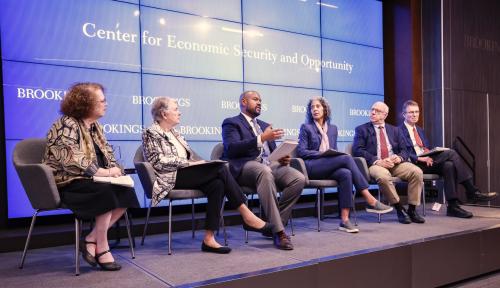Welfare reform is being widely heralded as a success. But without attention to teen pregnancy and its corollary, single-parent homes, the reform’s victories may be fleeting. In the last decade, teen pregnancy rates have declined somewhat, but remain twice those of other industrialized nations. Unless this underlying situation is addressed, child poverty and other social problems are likely to increase.
Educating teens about the consequences of early sex while continuing to make contraceptives available can go some way toward solving the problem. So, too, can after-school or mentoring programs and holding young men accountable for their actions. But to really effect change, what is needed is a broader campaign to strengthen social norms against early sex and out-of-wedlock pregnancy.
POLICY BRIEF #38
Two years after the enactment of welfare reform, the new law is being hailed as a great success. Caseloads have declined by one third since the law was signed, and with fewer individuals to support, the states are flush with money. A strong economy interacting with tougher welfare rules and more support for the working poor is helping to turn welfare checks into paychecks. But the welfare system is like a revolving door. In good times, more people move off the rolls than come on and caseloads decline. But in bad times, exactly the reverse can occur. The only way to permanently reduce poverty and its associated expense is to stem the longer-term trends, such as more out-of-wedlock childbearing, that have historically pushed child poverty and caseloads up. Unless the states invest their surplus funds in programs aimed at preventing poverty, success may be short-lived or purchased at the expense of the children it was designed to help. If every recipient who finds a job is replaced by a younger sister ill-prepared to support a family, the immutability of the revolving door will once again prevail.
In enacting the Personal Responsibility and Work Opportunity Act of 1996, Congress failed to provide funds for early childhood education, inner city schools, or other measures that might have made a difference over the long haul. But it understood one fact all too well. Unless we can reduce teen, out-of-wedlock pregnancies and encourage the formation of two-parent families, other efforts are likely to fail.
Much more attention needs to be given to encouraging young people to defer childbearing until they are ready to be parents. Some of the funds freed up by the drop in caseloads ought to be invested in teen pregnancy prevention programs and in reconnecting fathers with their children. In the absence of such efforts, welfare reform’s current success is likely to be short-lived.
Family Structure and Welfare Dependency
Rising divorce rates combined with a huge increase in childbearing outside of marriage have led to a situation in which most children born today will spend some time in a single parent family. And since roughly half of these single parents are poor (Figure 1), large numbers of children are growing up in poverty as well. Indeed, the growth of single parent families can account for virtually all of the increase in child poverty since 1970 (Figure 2).
Figure 1:
Child poverty Rates by Living Arrangement of Child, 1996
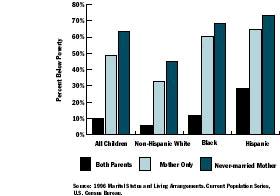
Figure 2:
Most of the Increase in Child Poverty Can Be Explained by the Growth of Female Headed Families
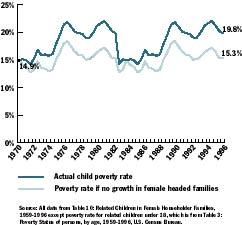
The growth of female-headed families has also contributed to the growth of the welfare rolls. According to the Congressional Budget Office, welfare caseloads would have declined considerably throughout most of the 1980s if it had not been for the fact that the growth of single parent families continued to push them upward. Moreover, this factor was more than twice as important as the economy in accounting for the roughly one million increase in the basic caseload between 1989 and 1993.
It is not just the growth of female-headed families but also shifts in the composition of the group that have contributed to greater poverty and welfare dependency. In the 1960s and 1970s, most of the growth of single parent families was caused by increases in divorce or separation. In the 1980s and 1990s, all of the increase has been driven by out-of-wedlock childbearing. Currently, 32 percent of all children in the United States and more than half in many large cities are born outside of marriage. Unmarried mothers tend to be younger and more disadvantaged than their divorced counterparts. They are overwhelmingly poor (Figure 1) and about three-quarters of them end up on welfare.
A large fraction of babies born outside of marriage have mothers who are not teenagers. However, the pattern of out-of-wedlock childbearing is often established at a young age. Specifically, more than half of first out-of-wedlock births are to teens. So if we want to reduce such births and the welfare dependency that usually ensues, the adolescent years are a good place to start.
There are two strategies that can be used to reduce teen, out-of-wedlock births. One is to encourage marriage. The other is to discourage sex, pregnancy, and births among teens. This latter strategy has the advantage of being more consistent with the growing requirements of the economy for workers with higher levels of education and with evidence that teenage marriages are highly unstable.
Out-of-Wedlock Childbearing: Cause or Symptom of Poverty?
Some contend that many of the women who have babies as unmarried teens would have ended up poor and on welfare even if they had married and delayed childbearing. The argument is that they come from disadvantaged families and neighborhoods, have gone to poor schools, or faced other adverse influences that make having a baby at a young age as good an option as any other. There are few men with jobs for them to marry, and given their own lack of skills, welfare seems like a relatively good alternative. Moreover, earnings for less skilled men have plummeted over the past 30 years.
Although such arguments cannot be dismissed entirely, they are only a small part of the story. To begin with, the drop in marriage rates, which has been especially pronounced among African Americans, has been much larger than any economic model can explain. Second, early childbearers are much less likely to complete high school, leading directly to poor long-term employment prospects for the young women involved. The children in such families suffer even greater adverse consequences, including poorer health, less success in school, and more behavior problems. Finally, the argument that declining earnings has made marriage less viable is a curious one. Two adults can live more cheaply than one, and by pooling whatever earnings can be secured from even intermittent or low paid employment, they will be better off than a single adult living alone. These arguments are doubly true once a child enters the picture and one parent either needs to stay home or shoulder the extra expense of paying for child care.
One can grant that the earnings prospects of poorly educated, inner city residents are not good and have deteriorated in recent decades, and that better schools and more support systems for low-income working families would help. Still, early out-of-wedlock childbearing greatly compounds the problem. Even well-educated individuals in their twenties have difficulty living on one income these days, and most middle class families have two earners. Yet, for some reason, it is assumed that if the men in low income communities can’t command a decent wage, they are not marriageable. But fathers are, or should be, more than just a meal ticket. And although two minimum wage jobs will not make anyone rich, they will provide an income of about $20,000 a year, well above the poverty level for a family with two children (Figure 3). In short, marriage and delayed childbearing have the potential to solve a lot of problems, including assuring a better future for the next generation.
Figure 3:
Marriage as an Anti-Poverty Strategy
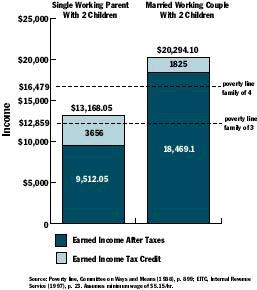
Why Are Teen Pregnancy and Out-of-Wedlock Birth Rates So High?
As teen pregnancy and childbearing have become more common, they have also become more acceptable, or at least less stigmatized. A few decades ago, there were real social penalties to be paid if a girl became pregnant outside of marriage. Young girls refrained from sex for fear of becoming pregnant and being socially ostracized. Among those who did get pregnant, shotgun marriages were common. Young men had to compete for women’s affections by promising marriage or at least commitment. All of this changed during the 1970s and 1980s. Contraception and abortion became much more available, women became more liberated, and sexual mores changed dramatically. An earlier Policy Brief (Number 5, August 1996) by George Akerlof and Janet Yellen documents how the decline in shotgun marriages contributed to a rising tide of out-of-wedlock births. But this same change in sexual mores led not just to fewer marriages but also to a lot more sexual activity and a rising pregnancy rate among the nation’s youth.
As Figure 4 shows, teen pregnancy rates increased from the early 1970s until 1990 and then declined a little during the 1990s. The relatively modest growth depicted in the chart is the result of two offsetting trends since 1972: increased sexual activity among teens combined with greater use of contraception. If teens had not increased their use of contraception over this period, teen pregnancy rates would have soared and been almost 40 percent higher by now. On the other hand, contraceptive use did not keep pace with the greater tendency of teens to engage in sex, with the result that, up until recently, the pregnancy rate kept rising. In the war between sex and safer sex, sex won.
Figure 4:
Teen Pregnancy Rate 1972-1994
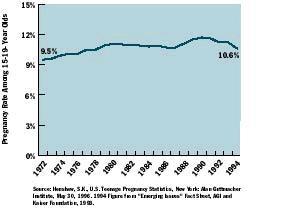
These increases in pregnancy rates have not always translated into higher birth rates. The greater availability of abortion after 1973 kept the teen birth rate somewhat in check. But few people, whatever their position on this difficult issue, want abortion to be the major means of preventing poverty and welfare dependency.
The Good News: Teen Pregnancy and Birth Rates Are Now Declining
In the 1990s, teenage sexual activity stopped increasing or even declined a bit. This combined with greater utilization of contraception among teens has caused the teen pregnancy rate to decline for the first time in decades. Teen births have fallen as well and the proportion of all children born out-of-wedlock has stabilized. The drop in birth rates among unmarried black teens is especially striking. It has declined by almost one fifth since 1991, a much sharper drop than that experienced by any other group. What has caused this recent turnaround in sexual activity, pregnancy, and out-of-wedlock births? No one really knows, but there are several possible explanations. One is fear of AIDS, which is widely suspected to be the most important reason for teens’ willingness to either abstain from sex or use contraception more frequently than in the past.
Another possible explanation is welfare reform itself. Although the trends predate welfare reform, they may have gotten an extra push from the debate leading up to enactment of the new law in 1996 and the state reforms that preceded it. Most researchers don’t expect welfare reform to have a big impact on out-of-wedlock childbearing. (Past studies are somewhat inconsistent, but most find that welfare has had only minor effects.) However, the new law makes welfare, and thus unwed motherhood, as a life choice much more difficult. And past research may not be a very good guide to future behavior because it has been based on variations in welfare benefits across states, not system-wide changes that are accompanied by time limits and strong moral messages that have the potential to change community norms.
Another factor that can’t be dismissed is the performance of the economy over this period. The unemployment rate peaked in 1992 at 7.5 percent and has fallen sharply since. The long and very robust expansion, combined with increases in the minimum wage and in the Earned Income Tax Credit, may have helped to make work more attractive than welfare, and provided young women with more of a reason to defer childbearing. (This explanation is consistent with a surprisingly steep rise in the labor force participation of less educated single mothers since 1990.) And finally, tougher enforcement of child support laws may have made young men think twice before producing a baby.
Given All This Good News, Why Worry?
Although recent declines auger well for the future, it is worth remembering that teenage pregnancy rates are still at least twice as high as in other industrialized countries and higher than they were in the early 1970s. About half of these pregnancies are carried to term while the remainder either end with a miscarriage or are terminated by an abortion. Very few teen mothers put their babies up for adoption, or marry the baby’s father, a marked departure from practices 30 or 40 years ago.
All of these considerations suggest that unless welfare reform begins to modify the behaviors that cause such a large proportion of children to be born to young, unwed mothers, it may do little more than reshuffle poor mothers and their children between welfare and low-paid work or worse. With the help of a strong economy, states could end up being quite successful at moving existing recipients off the welfare rolls. But unless they also focus on the number of young, unwed mothers coming in the front door of the welfare system, this could be a hollow victory. Congress has created an incentive for states to reduce teen and out-of-wedlock childbearing by offering a bonus of $20 million annually to the most successful states, and this has served as a wake-up call for some governors. But as Richard Nathan at SUNY Albany reports, many states have been reluctant to address the issue, considering it too hot to handle. They have tossed this political hot potato to local governments and nonprofits.
What Else Can Be Done?
Efforts to reduce teen pregnancy have traditionally centered on sex education and family planning services. Sex education, although widely available, is often too little and too late to have much impact. The best curricula focus less on reproductive biology than on teaching adolescents the skills needed to handle relationships, resist peer pressures, and negotiate difficult situations. Although teens are using contraception much more frequently than in the past, and their preferred method—condoms—is widely available in stores, they do not typically use it consistently, especially when they are young. The result is that failure rates are high and unplanned pregnancies all too common. Even a 12 percent annual failure rate, typical for condom users, cumulates to an almost certain pregnancy in the dozen years between puberty and marriage or an adult job. Part of the problem is that the boys and young men involved are not held accountable for their actions. Although the new welfare law puts considerable emphasis on establishing paternity and collecting child support from fathers, up until now, most have had a free ride. Unwed fathers need to be offered the same work opportunities and be subjected to the same requirements as the mothers of their children. And if Congress wants to do something about the so-called “marriage penalty,” the place to start is with the Earned Income Tax Credit (EITC). As a result of the credit, a working single parent with two children can qualify for almost $4,000 a year. But if she marries another low-wage earner, she stands to lose most or all of these benefits. Congress should consider basing the credit on individual rather than family earnings. (A requirement that couples split their total earnings before the credit rate was applied would prevent benefits from going to higher income families.) Under such a revised EITC, incentives to marry would be greatly enhanced.
In the meantime, efforts to equip adolescents with the knowledge and the means to avoid pregnancy in the first place have been highly charged politically and have created a backlash by conservatives, and even by some moderates, who want more emphasis placed on abstinence. Public opinion polls show that over 90 percent of the public believes that abstinence is the appropriate standard for school-age youth, even though a majority still wants contraceptives to be available as a backup. (Contrary to what some believe, there is no evidence that teaching young people how to protect themselves causes them to have more sex than those who have not received such instruction.) As part of the 1996 welfare reform bill, Congress provided $50 million a year for abstinence education programs. Such programs have never been adequately evaluated and many experts are skeptical that “just say no” campaigns by themselves will have much effect. But there is new-found appreciation for the need to encourage abstinence, especially among younger teens. In addition, if these or other funds were used for programs such as mentoring, community service, or after school activities, it could make a difference.
Those looking for proven programmatic solutions to this problem are likely to be disappointed. The point is not that sex education, family planning, or after-school programs can’t be effective, but that without a change in social norms, their impact may be small. Conversely, an intervention that begins by affecting behavior in quite modest ways may eventually produce changes in norms that snowball into bigger long-term effects. Behavior is contagious. Teens, in particular, are enormously influenced by what their friends, parents, and heroes say and do. This suggests that programs not be judged only on the basis of their immediate effects but also on their potential to reorient peer culture. It also suggests devoting some funds to media campaigns and to support for community or youth-led efforts that focus on values and not just services. In conclusion, reducing teen pregnancy could substantially decrease child poverty, welfare dependency, and other social ills. Although little is known with certainty about how to advance this objective, states now have the opportunity to experiment with a variety of promising approaches that are critical to the longer-term success of current welfare reform efforts. Whatever approach states choose, they should remain cognizant of the importance of strengthening the social norm that teen out-of-wedlock childbearing is—to put it most simply—wrong.

